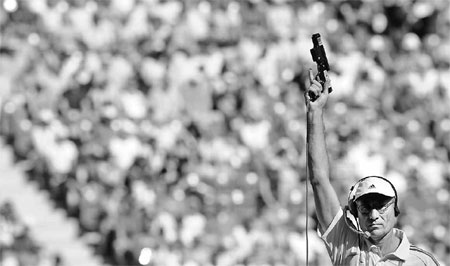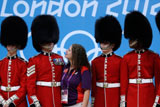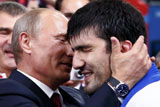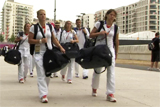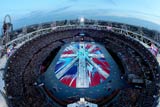Big shots still under the gun in London
Updated: 2012-05-10 08:07:56
By Reuters in Stockholm (China Daily)
|
|||||||||||
|
Franck Fife / Agence France-Presse |
Starter's pistol technology aims to eliminate false starts ... just try telling that to Usain Bolt
In a matter of milliseconds, Usain Bolt's aura of invincibility was shattered, not by a rival sprinter but by two sharp cracks of the starter's pistol. Bolt's disqualification from the world 100m final last year not only cast a shadow over the championships in Daegu, South Korea, but put the sport's draconian false-start rule firmly in the firing line.
It also shined a spotlight on the technology that will be a key component in a complex timing system assessing the performances of the world's best athletes at the 2012 London Olympics.
The starting pistol has come a long way from being an ordinary gun firing blanks to set athletes on their way. Its development has been influenced by a host of factors, from technical innovation to criminal legislation.
For much of the 20th century, starting pistols were modified versions of regular firearms used to fire blanks, with the barrels usually blocked or welded shut to prevent the firing of live ammunition.
But blank bullets and gunpowder are now a thing of the past, says Eckhard Frank, chief operating officer at Omega, the Swiss watchmakers tasked with implementing the timekeeping system at the London Games.
"Gunpowder and ammunition are difficult to transport around the world due to security reasons, and this is the reason why a new device was developed, to avoid any security problems," Frank said.
Omega introduced electronic timing to sport at the 1952 Olympics in Helsinki, and the London Olympics marks the 80th anniversary in all of its first involvement with the Games.
The modern starting pistol is now plugged directly into the timing system and is the first link in the timing chain. It is connected to a host of systems from stadium displays to pressure pads in the starting blocks.
One of the first difficulties to be ironed out was a simple physical problem - the report from the gun travels at the speed of sound, meaning the athletes closest to it hear it a fraction before everyone else in the race, giving them a tiny advantage over the competition.
To eliminate this advantage, modern starting systems now have loudspeakers behind each athlete to ensure they all hear the noise of the gun at exactly the same time.
Though these systems are now completely electronic, many starting pistols still emit a flash and a puff of smoke to simulate their less-advanced predecessors.
"The flash, also visible in strong sunlight, is necessary for the manual timekeeping and for the general tests of the whole installation," said Frank.
The modern system also helps eliminate the advantage and controversy surrounding false starts, such as that committed by Bolt in Daegu. Instead of human judges making the call, starting blocks now have pressure pads that measure an athlete's reaction time.
Once the pistol is fired, the athlete needs to hear the sound and then send the signal to his or her muscles that the race is on - this reaction time is set by the IAAF at 100 milliseconds, or 0.1 sec.
Imitation firearms
Under the current rules, any pressure on the pad before 0.1 sec of a second has elapsed means a false start.
Previously, athletes were allowed to make one false start in each race, but the introduction of the controversial "one and done" rule means that a single false start now leads to disqualification.
This is what happened to Bolt in the World Championship final in South Korea - the pressure pad indicated his reaction time was less than 0.1 sec, triggering a second shot that stopped the race and signalled his disqualification.
The system is also designed to ensure the starting pistol cannot cause a false start by going off accidentally.
"For the starter to be able to give the start signal, two green status lights will appear on the e-Gun; one indicating the timekeeping is ready for the start, and the other that the system measuring the reaction time is ready; only when these two status lights are on, the starter can use the gun," said Frank.
Aside from improvements designed to help athletes and eliminate false starts, manufacturers have had to adapt to the needs of governments seeking to curb the use of starting pistols by criminals as either real or imitation firearms.
Many countries now insist starting pistols be brightly-colored to differentiate them from proper pistols.
In the United Kingdom, a specific type of starting pistol - the Bruni Olympic .380 BBM - has been outlawed due to the ease with which it can be converted to fire live ammunition.
With the Games due to start in London on July 27, competitors will be spending much of their time between now and then honing their reactions to the starting pistol to make them as fast as possible.
But as the world's fastest man found out in Daegu, it does not pay to jump the gun either.
(China Daily 05/10/2012 page23)
Medal Count |
||||
| 1 | 46 | 29 | 29 | |
| 2 | 38 | 27 | 22 | |
| 3 | 29 | 17 | 19 | |
| 4 | 24 | 25 | 33 | |
| 5 | 13 | 8 | 7 | |
| 6 | 11 | 19 | 14 | |

